3DPrint.com | The Voice of 3D Printing / Additive Manufacturing |
- 3D Printed School and Tiny House Set Additive Construction Precedents for COBOD
- Uses for 3D Printing Exist. Companies Just Suck at Finding Them
- 3D Printed Alt Meats over Killed Animal Cuts? Investors Agree
- Eplus3D and Oqton Partner to Automate Metal 3D Printing for Denistry
- Metal 3D Printed Model Offers Insight into Earthquakes’ Seismic Waves
| 3D Printed School and Tiny House Set Additive Construction Precedents for COBOD Posted: 31 May 2022 07:00 AM PDT COBOD, the Danish additive construction (AC) firm, is known not only for its consistency and precision, but equally so for the innovative projects that its technology allows its customers to achieve. Against the backdrop of GE Additive's recent move to become an investor in the company, two new builds that COBOD customers have completed highlight exactly what sets the company apart in the AC sector. First, Thinking Huts, a non-governmental organization (NGO) focused on deploying AC to build schools, completed its first solo project, in the city of Fianarantsoa, Madagascar. Thinking Huts was founded in 2015 by recent college graduate, Maggie Grout, when she was only 15 years old. Previously, in 2021, the NGO also collaborated with 14Trees — a joint venture between Swiss cement giant Holcim and British International Investment (formerly CDC Group), the UK government's development finance arm — on the first 3D printed school, in Malawi. Now 22, Grout told the BBC that Thinking Huts plans on building another school, in a village also in Madagascar. As with the Malawi build, Thinking Huts' pilot project in Madagascar also relied on COBOD's BOD2 printer.  Danish startup 3DCP Group built the other project, a tiny house in Holstebro, Denmark. At only 37 square meters, or just under 400 sq. ft., the home was designed for student living by the cutting-edge Danish firm, Saga Space Architects. It was also built using a BOD2. In addition to being Europe's first 3D printed tiny home, the other, even more exciting thing about the 3DCP Group build is the roof. Typically, in the so far quite limited history of the sector, the roofs of 3D printed homes have been built using conventional methods. Saga Space Architects' design, on the other hand, included a printed roof, achieved by producing five separate panels off-site, which were then lifted and casted together at the time of the build, as shown in the video below. Another notable and unusual aspect of the project, as noted in the above quote from Brich, was the use of real concrete, which helped reduce costs.  Even more than its share of the market, the range of builds its customers produce is what makes COBOD stand out. The above-mentioned investment in COBOD by GE Additive followed on the heels of COBOD's successful design and implementation of the world's largest 3D construction printer — or "multifunctional construction robot", as COBOD CEO Henrik Lund-Nielsen likes to say — at GE's new 3D printing construction R&D facility. Coupled with the company's experience in office buildings and schools, and now tiny homes, it's undeniable that COBOD's technology is truly modular. Finally, student living seems like a perfect way to help get the sector up to scale, especially when you consider the potential public money involved. And, not that they're the first company in the world to have 3D printed tiny homes, but I still think 3DCP Group is onto something in this case, because tiny homes of this particular size that optimize space would actually be a step up in most cases from current dorm living. 3D printed homes are still far from being less expensive than conventionally built homes, but it's also still highly possible that they eventually will be. When you combine it with other factors like tiny home design and government grants, it's not unreasonable to think it could happen sooner rather than later. Images courtesy of COBOD The post 3D Printed School and Tiny House Set Additive Construction Precedents for COBOD appeared first on 3DPrint.com | The Voice of 3D Printing / Additive Manufacturing. |
| Uses for 3D Printing Exist. Companies Just Suck at Finding Them Posted: 31 May 2022 06:30 AM PDT I’m seeing something curious happening. In personal conversations, I’ve heard people exclaim that there are not enough 3D printing applications. People are arguing that it is this lack of use cases that is holding the technology back. Worse still, some are indicating that 3D printing is of limited use. Well then, maybe there are only five things that we can do with additive manufacturing (AM). Maybe we’ve reached a limit of some kind? Maybe we should just consign ourselves to irrelevance. I’ve given a riposte to this in more subtle form across some other articles, but here I’ll be clearer:
Now, I’ll break down each of these points to explain exactly what I mean. 3D Printing Is Not about the Tech Specs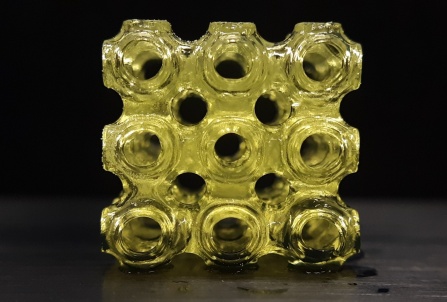 A 3D printed structure with ferroelectric properties. Image courtesy of PNAS. Often, 3D printing firms get stuck in the specs. They’ll think that a larger printer can solve it all. Or they think that if they qualify aluminum, the client will proceed. Companies get stuck in the weeds for years and months improving the tech specs without understanding that this is not the problem. Of course, if we could make a part in a second instead of a week, we’d find more adopters. However, there are a great deal of adopters out there, in fact. We´re just not talking to the right ones about the right things. Rather than focus just on the specs, lets focus on customer value or improving the customers business. 3D Printing Is about Demonstrating ValueWhereas companies are excited about 3D printing and want to explore it, there is often no well-defined value ascribed to the technology or a given AM project. To put it more cynically: for an additive deal to make sense, there has to be mutually perceived value. There is curiosity about the technology, but it is rarely ever any perceived concrete value that is recognized by both parties. So, we make a very expensive desk toy for someone. We pick the wrong part and everyone concludes that the technology is fun, but not necessary. However, we know that once all the hearing aid guys see we can save them money while inexpensively manufacturing a more comfortable product for their customers, we wipe away the whole In The Ear hearing aid industry in just a few years. Yet, rarely do people demonstrate value to the entire value chain or stack advantages to force applications ahead. “F” is for “Finance”We’re often talking to R&D, technology, manufacturing, business development teams to get our work done. What we haven’t developed is the vocabulary and body of knowledge to make ourselves heard in a conversation with the CFO. They may want to listen if we can demonstrate that we can save them X million dollars; if we can prove that we can free up cash flow by making spare parts; or if we can quantify what effects a faster time to market has and how we can bring it about. We’re too vague for the finance people. We’re not talking to our own finance people in trying to figure out what may trigger the finance department’s interest at the client either. We’re not quantifying and measuring the savings, margin increases, or other advantages that we can bring about. Finding New Applications Is Difficult, and Unlocking Them Is Hard.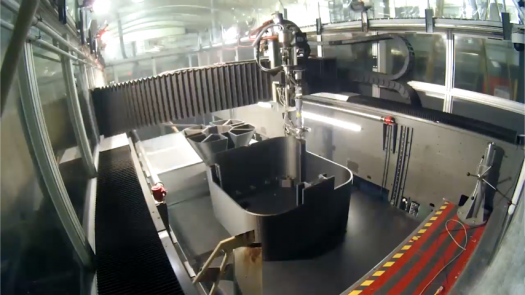 A submarine hull Finding new applications takes time, patience, experience, and a working knowledge of 3D printing coupled with versatile and creative minds. It also requires cross-disciplinary teams working together, and often including partnerships or deals with other players. It is not easy and not something that you can do in a quarter. It takes sustained effort, lots of exploration, lots of testing, and a methodical approach. Its’ a difficult set of skills to find in a single individual or team. It’s also difficult for such a team to balance out help from across their organization, budget, relevance, and management. Once an application has been found, unlocking it, proving that it works, and scaling it is also very difficult. Shifting towards manufacturing is difficult also. Selling it internally, getting more budget, and partnering here make it also very complicated. Rolling Out 3D Printing Applications Is Even Harder.The greatest thing holding back 3D printing is institutional resistance. Most of the time, we’re going to be sweeping in with new ideas, tools, methods, and concepts ready to wash away all that lies before us. This rides roughshod over established procedures, egos, and power structures. Even worse, we’re messing with people’s sleep at night, and their KPIs. Often, we’re trying to introduce a new way of working to someone who does not benefit from this change in any way . Skepticism can often not really be parlayed because we simply don’t have a track record. Colliding with complex decision making units and this institutional resistance is what strands 3D printing implementations. Often there is little empathy towards the “sticks in the mud,¨ which means that people are unable to work with stakeholders to deploy the technology. Instead, they dig themselves in foxholes to battle institutional resistance without assuaging any fears or taking away root causes. We have yet to develop any tried and trusted paths to ameliorating this problem. The Applications Themselves Are a Moving TargetWe know that the applications are a moving target, but don’t really appreciate it. We know that 3D printing is a slow moving technology but we do improve. Often, I see companies look for bullseyes. In a scattered brainstorm, people try to find that one golden goose. But they are not systematically looking at material and machine costs and part costs in a comparative way. People are not revisiting old initiatives when technology advances. We’re not making detailed comparisons whereby we keep track of why things work and what size or quality of part works, and what does not. We’re just chasing chimera and maybe copy-pasting an Excel table into the Power Point. We are not methodical. This is relevant because, if you map things, then you can see that, for example, if we can reduce prices by 50%, then we can suddenly 3D print a million valve bodies for oil and gas. 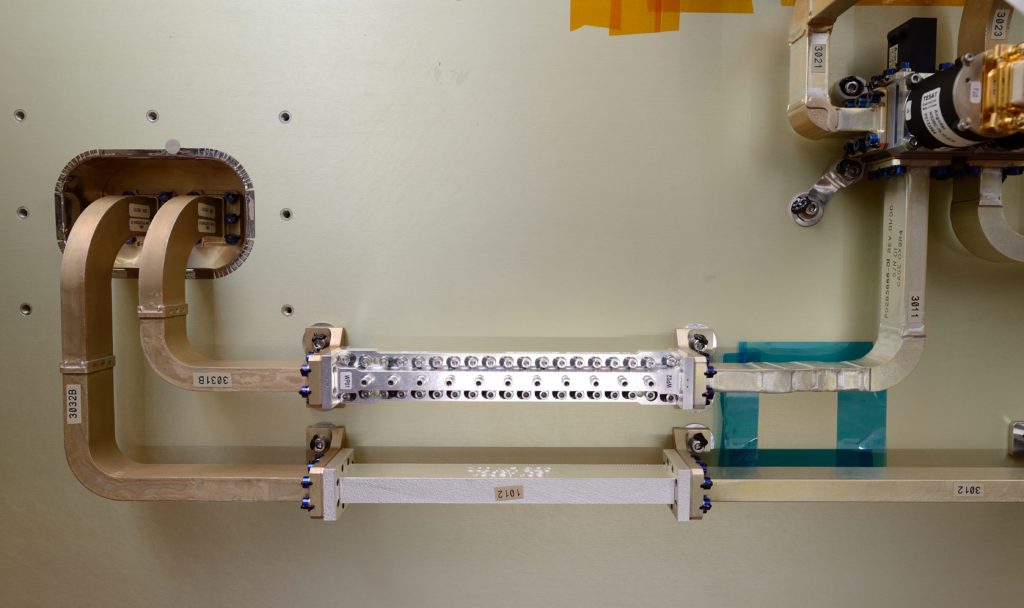 The 3D printed RF filter designed by Airbus Defence and Space integrated into the satellite payload. The new filter reduces weight by 50% over the previous design. This means that we need to revisit old assumptions, be more methodical in our approaches. However, it also means that, perhaps, we should try reversing the horse and the cart for once. The right approach may just be: “If we can reach X price, would you order 10,000?” This will only work if you can align the other entities in the value chain and get them to rally around a joint proposition. A lot of individuals are looking at this in a British Airways kind of way: “Given the current economics of my market, what parts can magically be made?” Very few are looking at it in an easyJet or Southwest Airlines kind of way, where a different accounting, different way of looking at the situation could lead to a completely new way of looking at your business. There Are Lots of 3D Printing Applications out there yet to Be Discovered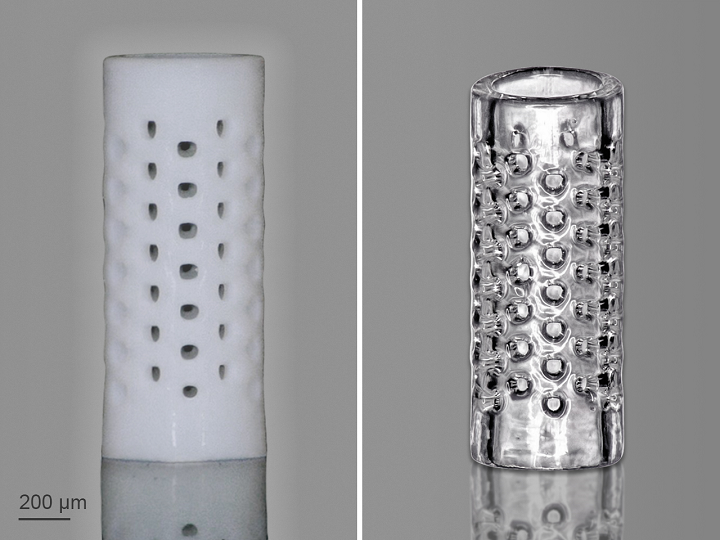 Green part of a 3D printed filter tube (left) and corresponding filter tube after the sintering process (right). Glass microstructures are suitable for sterilization and typically biocompatible, making the printing material GP-Silica a good choice for life science applications. A good friend once pointed out to me the incredible degree of strategic replication that businesses pursue in the 3D printing industry. It changed how I thought completely. Often, there is a real sense that orthopedics, aviation, space, and automotive are IT. We’re all talking to the same 100 individuals in the same few industries and they’re bored. You can’t make headway because you’re the fifteenth person to try to penetrate Toyota with the same ideas and same economics. And they still want to pay $1 for something we can make for $10. So few people are looking at new ideas and new industries. We need to talk to new people, with new ideas, and new components. We are not using our own technology to make unique solutions for new problems. Instead, we’re all riding around the same corral trying to catch the same cows with the same tricks. Put another way: It’s like surfing the World Wide Web and concluding that Yahoo! and physics department websites were already a done deal and concluding that the Internet would go no further than that point. That’s absurd given just how many part-shaped problems and solutions are out there. Anywhere where a unique texture, internal texture, geometry, or property addresses a significant issue, we will find value for clients. Some problems could be one-offs, others high-margin niches, and some a series of parts and solutions. We shouldn’t have to scale everything because the fact that we don’t have to scale is a key advantage of our technology. So, millions of parts shouldn’t be in your thoughts all the time. The right solution at the right price should be on your mind.
You’re Doing It WrongHere is a bit of a warm bath at the end of this article. You’re doing it wrong. Not only are you doing it wrong, but everyone else is as well. No one has it figured out yet. No one knows what the right methodologies are, how to implement things, how to grow these businesses. No one can do this well. What’s worse than getting lost in the herd trying to be like everyone else? Getting lost in a herd that doesn’t know where it is going. No one knows. Think clearly, persist, be methodical and creative and, perhaps, you could be one of the few to figure it out. The post Uses for 3D Printing Exist. Companies Just Suck at Finding Them appeared first on 3DPrint.com | The Voice of 3D Printing / Additive Manufacturing. |
| 3D Printed Alt Meats over Killed Animal Cuts? Investors Agree Posted: 31 May 2022 06:00 AM PDT For a while, it seemed as though 3D printed alternative meats were just one side of an industry, targeted mainly at the vegan or vegetarian population (roughly 14% globally). Now, it turns out that even meat-eaters are eager to get into an entirely new niche food sector that responds to our generation’s environmental, health, and dietary concerns. Of course, we still don't know whether 3D printed meat, fish, poultry, and other exotic meats could become the next normal, but so far, investors keep pumping money into startups that promise to deliver a new food trend. According to data collected by 3DPrint.com, since 2015, the very niche 3D printed meat sector… The post 3D Printed Alt Meats over Killed Animal Cuts? Investors Agree appeared first on 3DPrint.com | The Voice of 3D Printing / Additive Manufacturing. |
| Eplus3D and Oqton Partner to Automate Metal 3D Printing for Denistry Posted: 31 May 2022 05:30 AM PDT 3D printing software developer Oqton, a subsidiary of 3D Systems (NYSE: DDD), has partnered with Chinese metal laser powder bed fusion (PBF) maker Eplus3D to combine solutions for the dental market. Together, the companies will apply their respective solutions and expertise to create automated dental solutions with full traceability. SmarTech Analysis suggests that, through 2030, the dental 3D printing market will be the slowest growing sector, due to the relative maturity of the segment. Now, we are going to see a refinement and full establishment of a complete dental 3D printing workflow. In the case of this latest partnership, this means the introduction of software automation to 3D printed metal components. While patient-specific dental restorations are already made with additive manufacturing (AM), there is still a great deal of human intervention in the design of the final model. Moreover, regulations and certifications such as the EU Medical Device Regulation and ISO-13485 require traceability across the entire process as it relates to people, machines, and materials. By working together, Oqton and Eplus3D hope to streamline this process. Oqton's Manufacturing OS will provide full transparency and traceability to Eplus3D customers. The platform automates the workflow, from design to file prep, thus reducing the need for human intervention. Included in the software is high-density layered nesting and interlocking 3D nesting of removable partial denture frames. In addition to optimized support strategies that require less post-processing time, this enables greater machine productivity. Oqton's machine execution system (MES) software also includes scheduling and planning for equipment, materials, and workers across multiple production sites, including full version history for regulatory compliance.  Dental frameworks printed by the Eplus3D metal dental 3D printer EP-M150. Image courtesy of Eplus3D.
One customer of the solution, MT3D, is already weighing in on the technology. Willem Van Cauwenberge, head of engineering, noted, "Oqton allows us to get the most out of our Eplus3D printer. It significantly simplifies and improves our workflows compared to our previous software solution, and more importantly, for dental parts, it almost completely automates the data preparation. Oqton saves us invaluable time setting up each build." Oqton was acquired by 3D Systems in 2021 and we are already seeing the benefits the technology can bring a specific vertical. Under its former CEO VJ Yoshi and continued under more recent CEO Jeff Graves, the company focused on bolstering particular industries and applications. Its medical and dental division, 3D Systems Healthcare, represented the paragon of this strategy in that regard. This was then ported over to industrial 3D printing. Therefore, we may expect a similar plan for Oqton, as its MES tools are applied to other sectors. Interestingly, Eplus3D is a competitor to 3D Systems' own metal 3D printing line, demonstrating a commitment to the machine agnostic approach of the subsidiary. EOS President of North America Glynn Fletcher explained that he wasn't particularly worried about the increase in Chinese competition, due to increased nationalism for domestic production. It seems that 3D Systems isn't concerned either, in this case. Perhaps, given the strengthening of native supply chains being pursued by most nations and businesses is playing out, as Fletcher argued. Another aspect of the competition here is on the MES front. So far, 3D Systems is one of only a handful of MES developers. Materialise (Nasdaq: MTLS) is the other large firm in the business against mostly startups, aside from EOS-backed 3YOURMIND. 3D Systems CEO Jeff Graves suggested that the entire industry will advance if Oqton remains agnostic and Materialise Senior Marketing Director of Software Hans Van Glabeke argued the same thing when we spoke to him at RAPID + TCT 2022 about the company's CO-AM software and MES ecosystem. Therefore, it may be true that the tide of MES will lift all 3D printing boats to the level of industrial production. The post Eplus3D and Oqton Partner to Automate Metal 3D Printing for Denistry appeared first on 3DPrint.com | The Voice of 3D Printing / Additive Manufacturing. |
| Metal 3D Printed Model Offers Insight into Earthquakes’ Seismic Waves Posted: 31 May 2022 05:00 AM PDT It seems like no matter where you live, there is some sort of extreme weather situation to deal with; I’m in Ohio, so we have tornadoes all spring. In more tropical climes, like Australia, India, and North America’s Gulf Coast, there are hurricanes, and blizzards are fairly common in the upper Midwest and the Great Plains, though they can also strike high altitude mountaintops in the tropics. Out west, and in places like Nepal and Haiti, there are earthquakes, which have always seemed really scary to me; more than 9,000 people were killed in a huge earthquake in Mexico City in 1985, even though its epicenter was over 200 miles away. But researchers at the University of Chicago are using 3D printing to learn more about how the ground shakes after an earthquake, and how the layers underground can either increase or decrease the damage.  University of Chicago geoscientist Sunyoung Park shows seismic wave simulations from a new technique that uses metal 3D printers to better understand earthquake shaking. University of Chicago geoscientist Sunyoung Park shows seismic wave simulations from a new technique that uses metal 3D printers to better understand earthquake shaking.Different layers, built up over billions of years, make up the ground, and they’re all different—some may be brittle, others soft. During an earthquake, these layers all react differently, and seismic waves can ricochet depending on how intense and deep the quake is, in addition to nearby geography. So it’s very tricky to predict the damage an earthquake might cause. For instance, Mexico City is built on an ancient basin that’s surrounded by mountains, and researchers believe that the area’s soft foundation caused the shaking to be stronger, which led to terrible damage. Computer models help a little, but they’re not perfectly accurate.
Physical models of the ground have also been tried, but they take a long time to make, and the scope and range is limited at best. But 3D printing might be a better approach for modeling an earthquake. Park and the other researchers published a paper on their work, describing how they used a Concept Laser M2 Cusing metal 3D printer, and its direct metal laser melting (DMLM) technology, to gain a better understanding of how seismic waves move through the ground. The printer’s laser heats stainless steel powder to form multiple layers on top of each other, and by changing up the speed and intensity of the laser, it can actually simulate different rock types by making the layers more dense or porous.
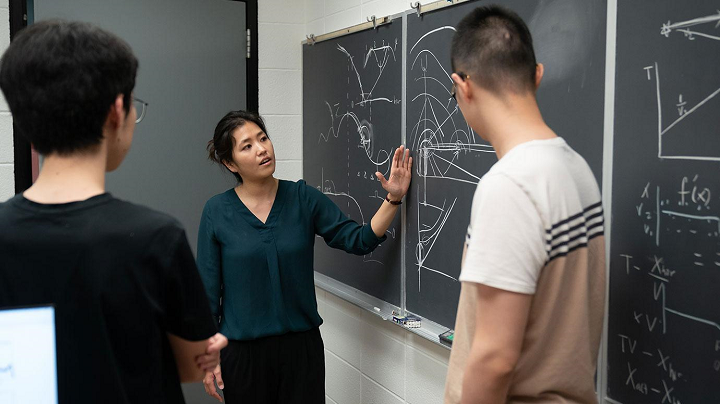 Park, center, works with members of her group Sifang Chen, left, and Jiong Wang, right. Park, center, works with members of her group Sifang Chen, left, and Jiong Wang, right.The team wanted to study how seismic waves with differing frequencies spread through the ground, and specifically focused on high-frequency waves, as they’re believed to be responsible for more building and infrastructure damage. Using the printer, they 3D printed an 8 inch-long replica, at a 250,000 to 1 scale, of the rock underneath Los Angeles, which is not dissimilar to the rock under Mexico City. Using lasers and other equipment, the researchers simulated an earthquake, and monitored the 3D printed model to see how the waves moved through the layers. According to Park, the results were very similar to data recorded during actual earthquakes, but they were surprised by some findings, such as the fact that “the high-frequency waves are more diminished” within the basin, “which is almost exactly the opposite of what was previously thought.” Because other scientists observed that low-frequency waves were amplified within a basin environment, they figured it would be the same way for high-frequency waves. But using the metal 3D printed model, the UChicago team discovered that high-frequency waves seem to reflect off at the edge of the basin.
 Setup for the seismic experiments on the 3D printed model. Thin arrows show the locations of the laser source (red) and receiver (blue). Thick red arrow shows the direction at which the laser is scanned along the top side of the model. Setup for the seismic experiments on the 3D printed model. Thin arrows show the locations of the laser source (red) and receiver (blue). Thick red arrow shows the direction at which the laser is scanned along the top side of the model.In addition to the fact that it only takes a few hours to print one of these models, they can also be reused; Park said that the team has used its Los Angeles replica in over 2,000 experiments. Plus, she believes that these models could be used for similar types of research as well.
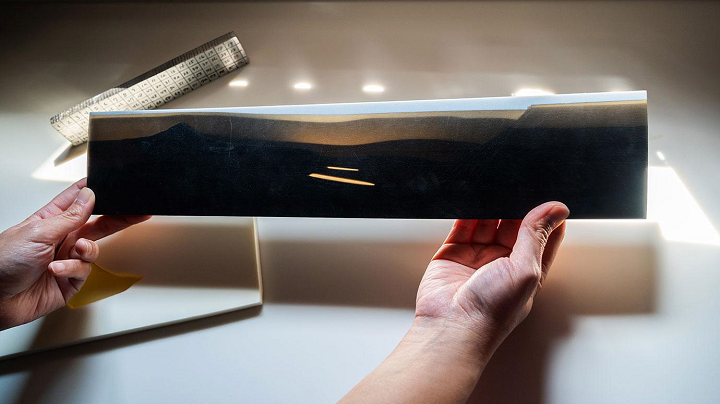 Park holds a prototype model, which is made in translucent material to show the layers. The metal block to the left is a completed model representing the ground below Los Angeles. Park holds a prototype model, which is made in translucent material to show the layers. The metal block to the left is a completed model representing the ground below Los Angeles.(Source: University of Chicago / Photos by Jason Smith) The post Metal 3D Printed Model Offers Insight into Earthquakes' Seismic Waves appeared first on 3DPrint.com | The Voice of 3D Printing / Additive Manufacturing. |
| You are subscribed to email updates from 3DPrint.com | The Voice of 3D Printing / Additive Manufacturing. To stop receiving these emails, you may unsubscribe now. | Email delivery powered by Google |
| Google, 1600 Amphitheatre Parkway, Mountain View, CA 94043, United States | |




0 comments:
Post a Comment